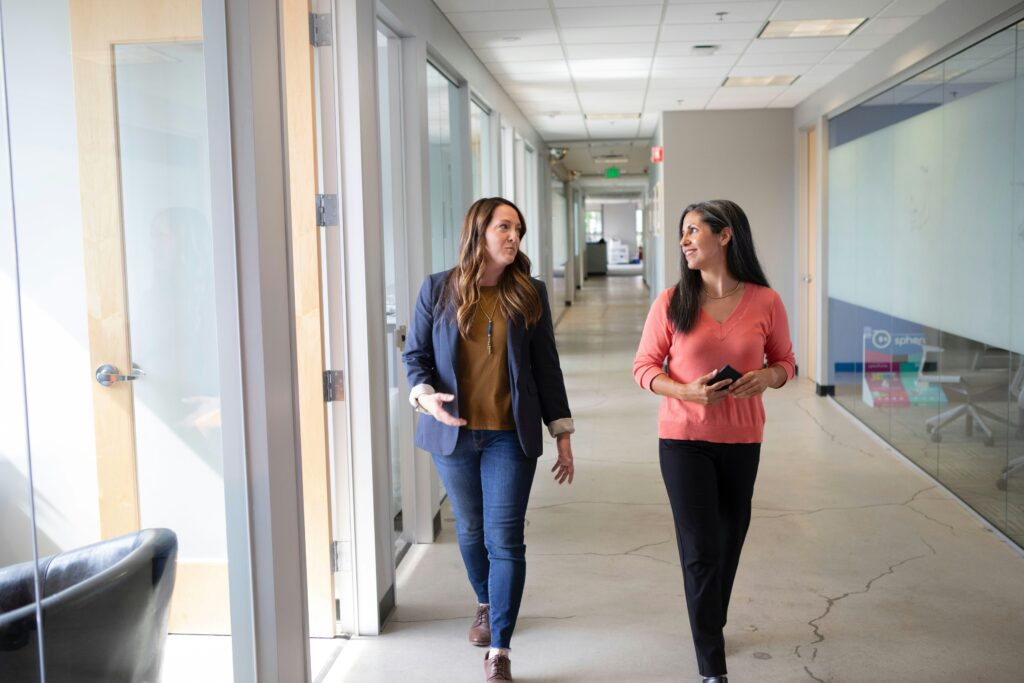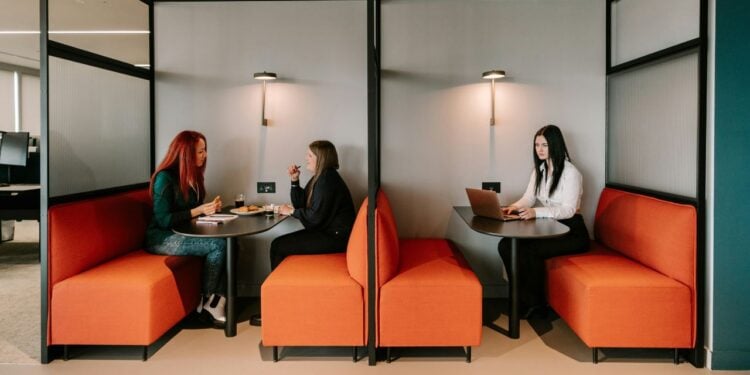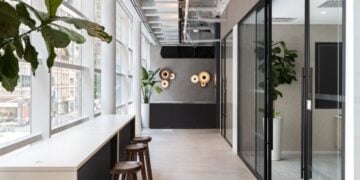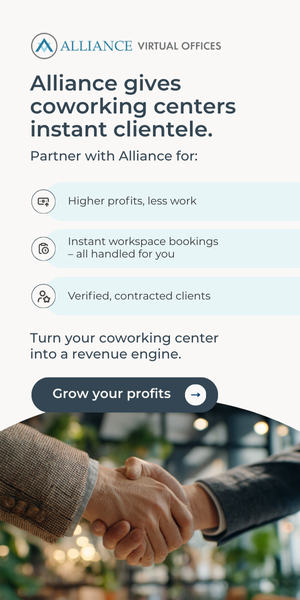- The office is evolving to prioritize social connection and comfort, with companies investing in design that draws people together while making spaces feel more residential.
- Workplace flexibility is becoming more nuanced, focusing on hybrid workstyles to find the right balance for organizations and teams.
- There’s growing optimism about workplace growth in 2025, with most companies planning to expand headcount and increase pay while adapting to major shifts like AI integration.
As we start the new year, the workplace is changing yet again. We tapped workplace experts to share their take on what to expect from 2025, from office design to employee wellness. Here are their projections for the coming year.
The office will continue to be about connection. And design matters.
“One of the big things in 2025 is social connection,” says Lenny Beaudoin, executive managing director and global lead of workplace strategy at commercial real estate firm CBRE.
Office amenities will be key going forward. He expects to see companies invest in unique amenities, whether it’s a genius bar for computer help or more outdoor spaces and cafes.
“We know that when people have shared experiences, they’re stickier to their organizations, and that is kind of intuitive,” says Beaudoin.
The number of companies adding conference rooms and meeting spaces has leveled off, and today’s cool offices look a lot like they did pre-pandemic, he says.
They’re providing less dedicated, individual offices and desks and more flexible solutions that support hybrid work.
One emerging trend is the adoption of modular acoustic furniture systems like ROOM’s Acoustic Lounge, which flexibly creates privacy within open spaces through sound-dampening technology, helping to maximize space while supporting various work modes brought about by hybrid work.
These innovative solutions offer everything from single-seat focus areas to collaborative huddle spaces, helping organizations maximize their space while supporting various work modes.
That social piece, he says, is activated by having amenities, places that draw people together. “We’re seeing a real emphasis on this,” says Beaudoin.
People have gotten used to the comforts of home, and companies will continue to make the office more personable with residential furniture and designs.
This shift is evident in furniture that prioritizes both aesthetics and functionality, like the customizable fabric options of The Acoustic Lounge, mirroring the comfort of home while meeting professional needs.
Olivia Perron, designer at IA Interior Architects expects 2025 to usher in the need for more efficient space planning, intentional designs, and distinct brand identity.
As office footprints continue to shrink, the emphasis on efficient use of space grows. This is driving demand for intentional, multi-use spaces and environments that reflect their organization’s culture and values, she says.

Workplace flexibility will shift from location to lifestyle.
Most leaders have found the right balance that works with their hybrid work routine, says Beaudoin. “It’s favoring more time in the office with flexibility in the edges,” he says.
More leaders are headed into the office, and employees are following them. It’s clear people return to the office because they want to be there rather than because they’re required to be there.
To support this voluntary return, organizations are investing in adaptable furniture solutions that create touchdown spaces for hybrid workers while maintaining the privacy needed for focused work.
By 2025, the buzzword isn’t “remote” anymore—it’s fluidity, says Ira Wolfe, longtime HR consultant, author, and speaker on the future of work. Workplaces will evolve to accommodate not just where we work, but how and when, he says.
What works one month in one workplace, one department, or one team might not work the next.
“Where people work will depend on a delicate balance of productivity and personal priorities,” Wolfe says.

Burnout and anxiety will persist.
Expect widespread burnout, mental health challenges and loneliness to follow us through 2025.
Last year, 43% of adults said they felt more anxious than they did the previous year, up from 37% in 2023 and 32% in 2022, according to the American Stress Institute.
Not surprisingly, then, wellness will remain a top priority. Yet the old way of addressing those issues won’t work. Employers will be challenged to offer employees more time and flexibility instead of organized wellness programming.
More people are also talking about changing jobs, and we could see a resignation surge come January, says Sandra Moran, chief customer officer at WorkForce Software, which makes workplace software for managing time, attendance, scheduling, absence and employee communications globally.
Retaining those employees may depend heavily on investing in career development and skills training.
As many as 74% of Americans say they feel stressed about their job or career, and 80% of employees are likely to leave an organization if their potential skills aren’t recognized.
One study by the University of Phoenix found that 70% of people would stay throughout their career at their employer if they were given more opportunities to apply new skills.

AI will only get bigger.
Artificial intelligence is clearly revolutionizing everything, especially when it comes to managing people.
Employers are using AI to improve recruiting, to identify who to promote and to keep people engaged at work. It’s synthesizing data and delivering recommendations based on where employees are, who’s engaged, who’s not engaged, who’s active, who’s happy or unhappy.
“At this point, what app isn’t using AI? It’s either part of everything or will be part of everything,” says Dan Schawbel, managing partner at Workplace Intelligence, a workplace research firm.
Expect people to rely on AI even more in the coming year to automate administrative tasks, such as pulling research reports, processing invoices, or formatting annual reports. Leaning on the technology will open up more room for creative tasks, problem solving and brainstorming.
“AI will have an impact on the nature of work in offices and it will change the nature of work from being more autonomous to more collaborative,” says Beaudoin.

Employers are looking at growth.
At least 76% of surveyed employers say they plan to expand headcount in the coming year, with 53% anticipating modest increases and 23% expecting more significant growth, according to ZipRecruiter’s Second Annual Employer Survey.
Workplaces will need to evolve with increased headcounts, incorporating adaptive architecture to flex with their growth.
More than half of employers surveyed by ZipRecruiter say they’re planning pay increases of 1-4%, and about a quarter expect to offer raises of up to 5% or more. This is a sharp turnaround from 2023, when nearly half of employers (48%) reported resetting pay downward amid recession fears.
“Easing inflation and stabilizing interest rates are fueling employer confidence,” says Julia Pollak, ZipRecruiter’s chief economist.
That outlook and clear strategies around hybrid work also bode well for the office market.
Tenants are beginning to show renewed confidence in transacting both renewals and new deals, according to CBRE.
Vacancies have plateaued and should stay there until the end of 2025, and demand for quality spaces will remain high, too, says Julie Wheland, head of occupier research for the Americas at CBRE.
“Overall, 2025 is looking to be a much healthier year for the office market than has been seen in a while,” she says.
While there’s no crystal ball for 2025, last year’s challenges will surely follow us into this one. But it’s clear that leaders who embrace change, compassion and adaptability will be those who thrive in tomorrow’s workplace.


 Dr. Gleb Tsipursky – The Office Whisperer
Dr. Gleb Tsipursky – The Office Whisperer Nirit Cohen – WorkFutures
Nirit Cohen – WorkFutures Angela Howard – Culture Expert
Angela Howard – Culture Expert Drew Jones – Design & Innovation
Drew Jones – Design & Innovation Jonathan Price – CRE & Flex Expert
Jonathan Price – CRE & Flex Expert











